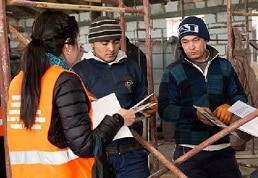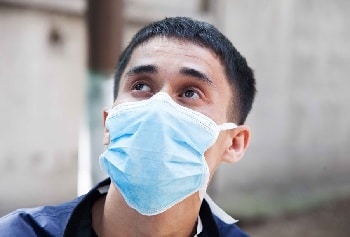
Project HOPE in Kazakhstan: Putting Lives Back on Track After TB
Kazakhstan has among the highest incidence of multi-drug resistant TB in the world and the large influx of labor migrants has posed serious challenges. Project HOPE programs address the treatment and prevention of TB.
Damir Bakhytzhanovich Doshchanov knew something was badly wrong when he fell ill last September. “I felt faint, coughed for several weeks. I was sweating, and lost my breath very easily ,” said the 27-year-old migrant living in Kazakhstan, where he had moved in search of work after growing up in a small village that is part of a republic in Uzbekistan.
Damir sought help in a local hospital and was treated by Banu Kalmagambetova, a social worker from an organization that is partnering with Project HOPE to combat cross border TB among labor migrants.
“I was educated about tuberculosis and the project and the importance of timely examination. I was diagnosed with tuberculosis and received support to adapt to hospital conditions and to prepare myself for a long treatment,” Damir said.
The Almaty region, where Project HOPE and its partner, the PF Taldykoran Regional Employment Assistance Fund is working, is the most populous administrative region of Kazakhstan. It attracts many migrants from neighboring countries, as well as from regions within the country, in search of more lucrative work from the booming energy and mining industries. However, these migrants are not always aware of their health problems which means that the very threat of tuberculosis (TB) can be very stressful for someone attempting to start a new life in a new place.
Kazakhstan has among the highest incidence of multi-drug resistant TB in the world and the large influx of labor migrants has posed serious challenges. Migrants have not had access to TB services due to a lack of information and legal, financial and language barriers. Even though Project HOPE and its partners launched a three-year program to improve TB services in the migrant community in 2014, Kazakhstan still faces a challenge in addressing TB control issues among its labor migrants. The stigma associated with TB can make patients feel isolated from the rest of the community and Project HOPE’s community-based approach has helped migrants find social support services to help combat the stigma associated with TB.
The “Addressing Cross Border TB, M/XDR-TB and TB/HIV Among Labor Migrants Program” aimed to remove these legal barriers in accessing care for internal and external migrants, to ensure TB prevention and care for migrants while strengthening community systems and increasing the role of civil society.

Project HOPE’s Impact
Project HOPE established pilot sites in areas with the highest concentration of labor migrants. This network of migrant-friendly medical facilities provided diagnostic and treatment services for migrants including those with an “undocumented” status. These services included information and education activities, outreach to migrants, referral to medical facilities and social and motivational support for treatment adherence. National and international technical experts from cross-sector working groups collaborated on a national manual about TB control and providing services to migrants.
Reaching out to the migrant community presents its own challenges. They are usually closed communities making it difficult for local health systems to reach migrants with TB symptoms and refer them to migrant-friendly health facilities. The solution: Project HOPE worked with local non-profit organizations to create a bridge between migrants, the health sector and government authorities. During the program’s implementation, they developed and issued cross-sectoral plans to implement TB control activities in pilot sites with representatives of local governments, health and labor departments and other organizations approving these plans and actively participating.
The success of the program shows that NGOs have proven to be team players in the battle to eradicate TB, especially when conducting activities among high-risk TB and difficult-to-reach key populations, making it easier for them to advocate for government funding for local partners and secure additional funding for outreach activities.
Today, Damir is doing much better.
“Thanks to Project HOPE, I received the necessary medical diagnostic testing and the treatment was prescribed,” he says.
“After being discharged to the outpatient stage of treatment and continued monitoring, I had difficulty paying for train tickets and the program helped me again to ensure I adhered to treatment. I am very grateful to everyone for their attention, support and assistance. Now I am sure that I will be healthy and will return to my family.”

Statistics on Migrants
Outreach workers and volunteers have reached approximately 145,000 migrants directly — and nearly 44,000 migrants passed active TB screenings.
TB notification among external migrants has increased four to five times in the three years since the start of the program.
The program pilots launched in 2017 detected TB in three out of four external migrants and, out of migrants with drug-sensitive TB detected in 2015 to 2016, more than 80% were treated successfully and 8.2% were referred to their home country to continue treatment.
The “Addressing Cross Border TB, M/XDR-TB and TB/HIV Among Labor Migrants Program” is funded by the Global Fund to Fight AIDS, Tuberculosis and Malaria (GFATM) and implemented by Project HOPE in partnership with WHO, the International Organization for Migration (IOM) and the International Federation of Red Cross and Red Crescent Societies (IFRC).
EDIT: This post has been updated.